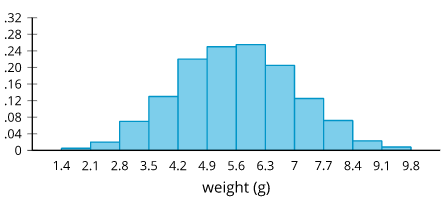Illustrative Math - Algebra 2 - Unit 7 - Lesson 8
By Formative Library
starstarstarstarstar
Last updated about 1 year ago
8 Questions
1
1.
A tetrahedron is a triangular pyramid with 4 equilateral faces. Han has a box of tetrahedrons with each of the 4 vertices marked with one of the numbers 1, 2, 3, and 4. He rolls one tetrahedron and makes note of the number on the vertex that points up. After rolling this tetrahedron 10 times, he notices that the number 1 appears five times.
Han suspects that this tetrahedron is weighted in some way to make 1 appear more often than the other numbers. Using another tetrahedron from the box that he has confirmed is fair (all of the numbers tend to be rolled with equal frequency), explain a process Han could use to gather evidence to show whether this tetrahedron is also fair.
S.IC.3

1
2.
1
3.
1
4.
1
5.
Based on classical genetics, two heterozygous parents should pass on the recessive trait to their children \frac{1}{4} of the time. A researcher puts 20 fruit flies that are heterozygous in a container, then examines the children. 46 of the 100 children have the recessive trait.
Is there reason to believe something is wrong with this experiment? Explain your reasoning.
S.IC.3
1
6.
The weight of each cookie in a batch of a certain type of commercially produced cookie follows an approximately normal distribution with a mean of 11.32 grams and a standard deviation of 0.03 grams.
Approximately what percent of the cookies weigh between 11.32 and 11.35 grams?
S.IC.3
1
7.
When Elena throws a shot put during track and field practice, it travels an average of 26 feet with a standard deviation of 3 feet, and the distribution of lengths is approximately normal.
Approximately what percentage of her shots will travel less than 23 feet?
S.IC.3
1
8.
Priya looks at this histogram of a distribution with a mean of 5.6 grams and a standard deviation of 1.4 grams. She claims that approximately 68% of the data is between 4.9 and 6.3 grams. What is the error in her thinking?

S.IC.3
This lesson is from Illustrative Mathematics. Algebra 1, Unit 7, Lesson 8. Internet. Available from https://curriculum.illustrativemathematics.org/HS/teachers/3/7/8/index.html ; accessed 29/July/2021.
IM Algebra 1, Geometry, Algebra 2 is © 2019 Illustrative Mathematics. Licensed under the Creative Commons Attribution 4.0 International License (CC BY 4.0).
The Illustrative Mathematics name and logo are not subject to the Creative Commons license and may not be used without the prior and express written consent of Illustrative Mathematics.
These materials include public domain images or openly licensed images that are copyrighted by their respective owners. Openly licensed images remain under the terms of their respective licenses. See the image attribution section for more information.